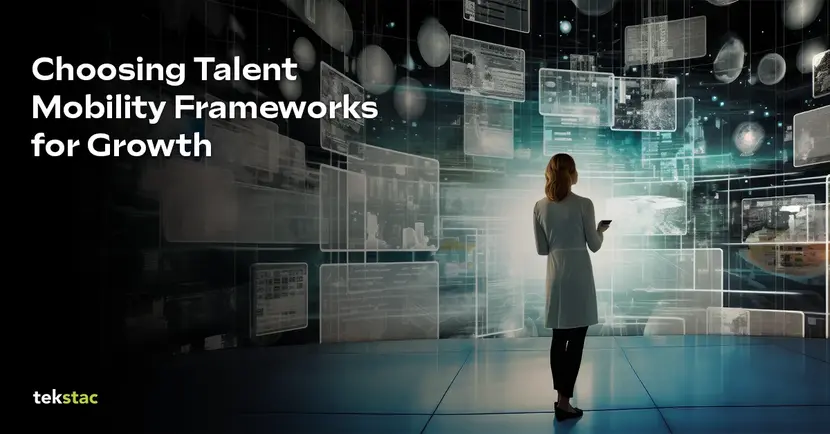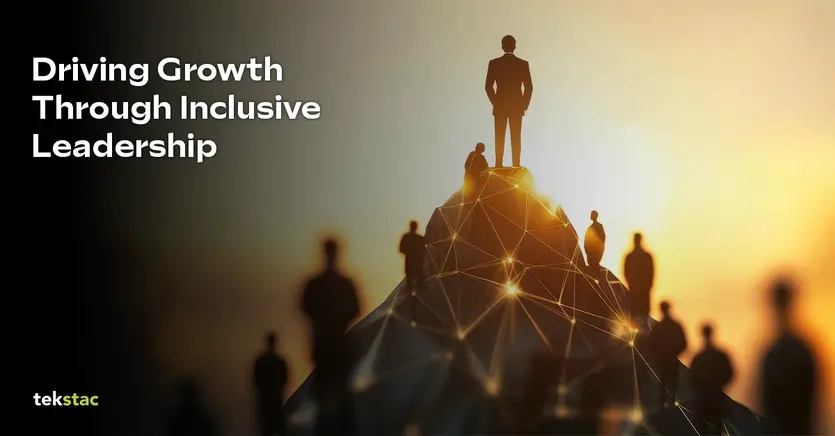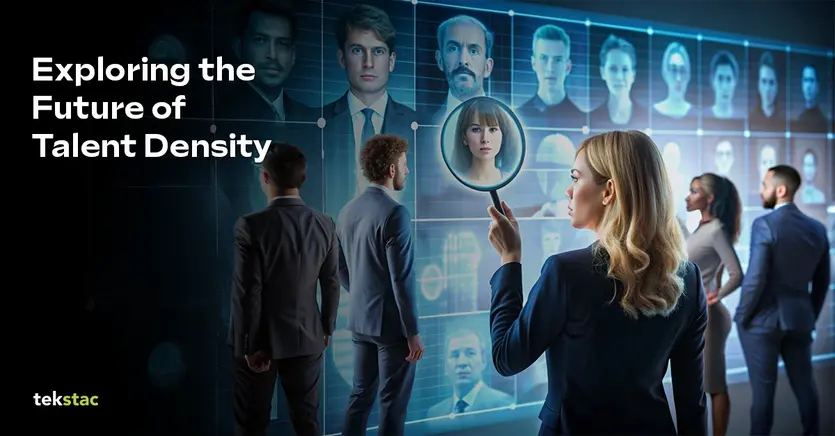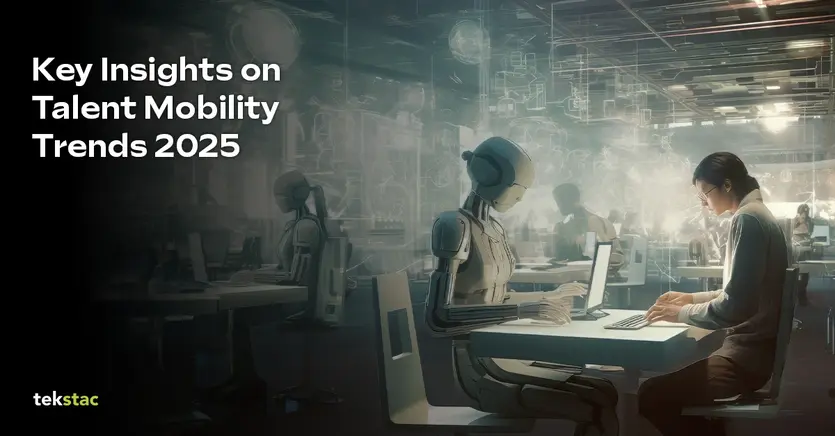10 Effective Strategies for Coaching Underperforming Employees
Coaching employees who struggle to meet expectations is an essential leadership skill that can transform workplace challenges into opportunities for growth. Low-performing employees can impact team dynamics, morale, and productivity, but leaders can turn these situations around with the right approach.
An effective coaching strategy can help employees overcome obstacles, develop skills, and regain confidence.
This article will explore ten practical strategies for coaching underperforming employees, helping you guide them toward success.
10 Effective Strategies for Coaching Underperforming Employees
A leader’s ability to coach employees struggling to meet expectations is one of their most essential skills. This ability can significantly impact individual and team performance, helping low-performing employees overcome challenges and contribute effectively to the organization.
According to research from Culture Amp, underperforming employees make up an average of 4% of an organization’s workforce. However, this percentage can range from 0% to 20% depending on industry type, organizational culture, and performance evaluation criteria.
An organization that can identify and support these employees will increase both performance and overall productivity, employee engagement, and workplace morale.
Different experts propose strategies to support employees in overcoming challenges and building the confidence necessary to excel in their roles.
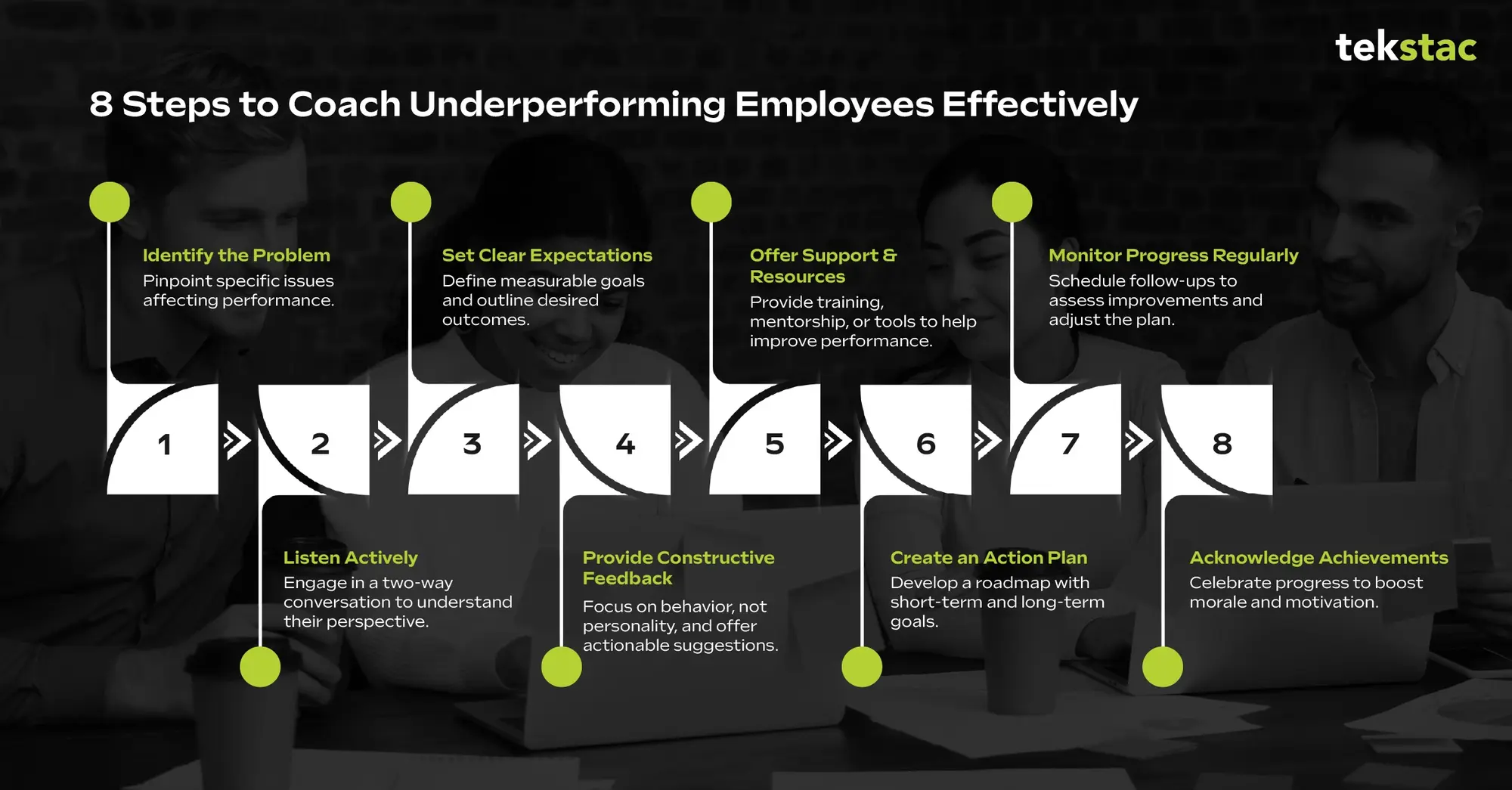
1. Identify the Root Cause of Underperformance
To help an underperforming employee, you must first understand what is causing the issue. Once you know why, it’s easier to tailor your approach to suit the individual’s needs; for example, if the problem is a skills gap, consider offering upskilling and reskilling opportunities to ensure the employee has the necessary skills to succeed.
- Surveys or a feedback form can help you discover systemic or individual issues.
- Look for patterns of behavior such as missed deadlines, discouragement to do the work, and struggle to participate.
- Feedback from other team members will help you get a complete picture if you are open to it.
2. Set Clear Expectations and Goals
Clear, measurable goals are essential to guide employees back on track. Goals prevent you and the employee from wondering what is expected and how success is measured.
- Performance reviews are a means to discuss and set short-term and long-term goals.
- Make your bigger goals more actionable, and more manageable.
- Make sure the goals fit the role and that they move the career forward.
3. Provide Regular and Constructive Feedback
Coaching is generative, and feedback is a powerful tool. Employees struggling to meet expectations greatly benefit from regular and constructive feedback, which helps them identify areas of improvement and take corrective action. Supporting low-performing employees with clear guidance can drive meaningful progress and growth.
Managers can play a crucial role when employees face a skills gap by offering targeted feedback and support to help bridge the gap effectively. This guide lists the most critical skills gaps employers prioritize in 2025 and provides actionable strategies for addressing them.
- Feedback after observing behavior should occur soon.
- Don’t use language that judges; think about what can be improved.
- Ask employees for their perspective on feedback make it a two-way conversation.
4. Offer Additional Training and Development Opportunities
At times, those who underperform fail to have the skills or knowledge. Training and development opportunities boost morale and bridge the skills gap in employees, and over time, they can boost performance. This training could take the form of formal classes, online sessions, mentoring, or hands-on workshops.
- State-specific skills the employee needs to develop.
- Have someone to do the learning with (a mentor or peer) to trigger more learning.
- Support the development of their career.
5. Foster a Supportive and Positive Work Environment
Better employee performance is a function of a supportive work environment. When employees are given value, respect, and support they are able to overcome obstacles and are more likely to perform at their best.
- Promote team collaboration and open communication.
- Reward small wins because you must recognize and celebrate them to gain morale.
- Celebrate strengths rather than weaknesses.
6. Break Tasks into Manageable Steps
Employees facing performance challenges may procrastinate or feel overwhelmed by large tasks or projects. Breaking these tasks into smaller, more manageable steps can reduce stress, clarify priorities, and foster a sense of achievement with each completed step.
- Divide large projects into smaller, attainable milestones.
- If you need to catch up with tasks, plan for regular check-ins.
- Maintain your motivation and confidence by celebrating each milestone.
7. Motivate Through Positive Reinforcement
One of the most powerful ways to increase performance is by motivating employees through positive reinforcement. Verbal or tangible rewards are only two forms of motivation out of many.
- In team meetings or via email, publicly acknowledge achievements.
- Let’s praise effort as well as outcome, not final results only.
- Ask employees to consider within themselves what they have improved upon.
8. Align Responsibilities with Strengths
Every employee has their strengths to help them succeed. You can achieve better performance by aligning your tasks and responsibilities with the strengths.
- Find out the employee’s essential strengths and interest areas.
- Reassign them to tasks or projects that better suit their skills.
- Check-in regularly to see if the employee has confidence in their role.
9. Encourage Ownership and Accountability
Empowering employees to own their work is one way to improve performance. Accountability creates a feeling of responsibility and motivates people to reach their full potential.
- The expectation for each task and its included responsibilities is set.
- Allow employees to think and act for themselves.
- You should hold employees responsible at the individual level accountable for their actions and the results they create.
10. Know When to Offer Additional Support or Make Tough Decisions
Sometimes, coaching will help resolve underperformance; sometimes, it won’t. If an employee’s performance doesn’t improve after coaching, you may need to use a performance improvement plan (PIP) or other alternatives.
- Coaching or mentoring (extended tenure) if work performance doesn’t improve.
- Offer additional support through professional counseling or employee assistance programs.
- If necessary, consider tough reassignment or separation while being fair and transparent.
Conclusion
Coaching underperforming employees requires patience, a deep understanding of their challenges, and the ability to guide them toward effective solutions.
Remember that there are reasons the team underperforms, and fixing them early on will do wonders for keeping the team productive and in a reasonable frame of mind. By continually adapting and changing your coaching methods to suit the needs of your employees, you will simultaneously see performance and satisfaction improve.
What strategies have worked for you when coaching underperforming employees? Share your tips, experiences, or insights in the comments below! If you’re looking for leadership and employee development support, consider checking out Tekstac.
Why Skills-Based Organizations Will Dominate 2025 and Beyond
When hiring, retaining, and managing top talent, the bar is being raised higher for organizations.
As of January 2024, 52% of US job postings on Indeed omitted formal education requirements entirely. Employers have shifted from degree-based requirements to skills-first hiring practices, which is only the first step.
This is a part of turning into a skills-based organization, where employers move away from traditional job titles and rigid roles. Instead, they focus on the actual skills employees bring to the table.
With the new technology tools sprouting and the increasing nature of remote work, businesses focus on people who could immediately add value with applicable, practical skills, aside from background or previous experiences.
To find and retain such talent, organizations must transform into skills-first organizations poised to dominate in 2025 and beyond.
What Are Skills-Based Organizations?
A skills-based organization is one that prioritizes the skills employees possess over traditional job titles or fixed roles. It structures teams and projects around the competencies required to drive business results. This allows employees to contribute based on their strengths and expertise.
Beyond hiring, a skills-based organization focuses on career development, promotions, or project management. Employees are assessed and advanced based on their skills and contributions rather than seniority.
For example, consider a company with defined roles, such as “Marketing Manager” or “Sales Representative.” Promotions are based on seniority, and employees are expected to stay in their roles for many years before moving up the ladder. For instance, a Marketing Associate role can only get promoted to Marketing Manager if the person has worked at the company for at least 5 years, regardless of whether they have mastered new marketing techniques or additional skills.
In contrast, a skills-based organization would recognize the value of new skills over years of experience or education. If the person possesses the right skills and knowledge, they would be promoted to leadership after demonstrating results with their abilities.
Why Skills-Based Organizations Are the Future of Work
The transition to a skills-based model is a foundational shift that aligns with the evolving future of work, where agility, adaptability, and innovation drive success. Organizations must rethink traditional approaches to hiring, training, and talent development to stay competitive.
Becoming a skills-based organization requires businesses to adopt a mindset emphasizing the importance of employees’ abilities and talents rather than background or experience. This helps focus on continuous learning and skill development to build high-performing teams.
Here are the top 7 factors that will drive organizations to turn into skills-based organizations in 2025:
- Technological advancements
- Remote and hybrid work
- Talent shortage and competitive labor market
- Emphasis on employee development and career growth
- Increasing focus on innovation
- Increased DEI efforts
- Changing nature of work
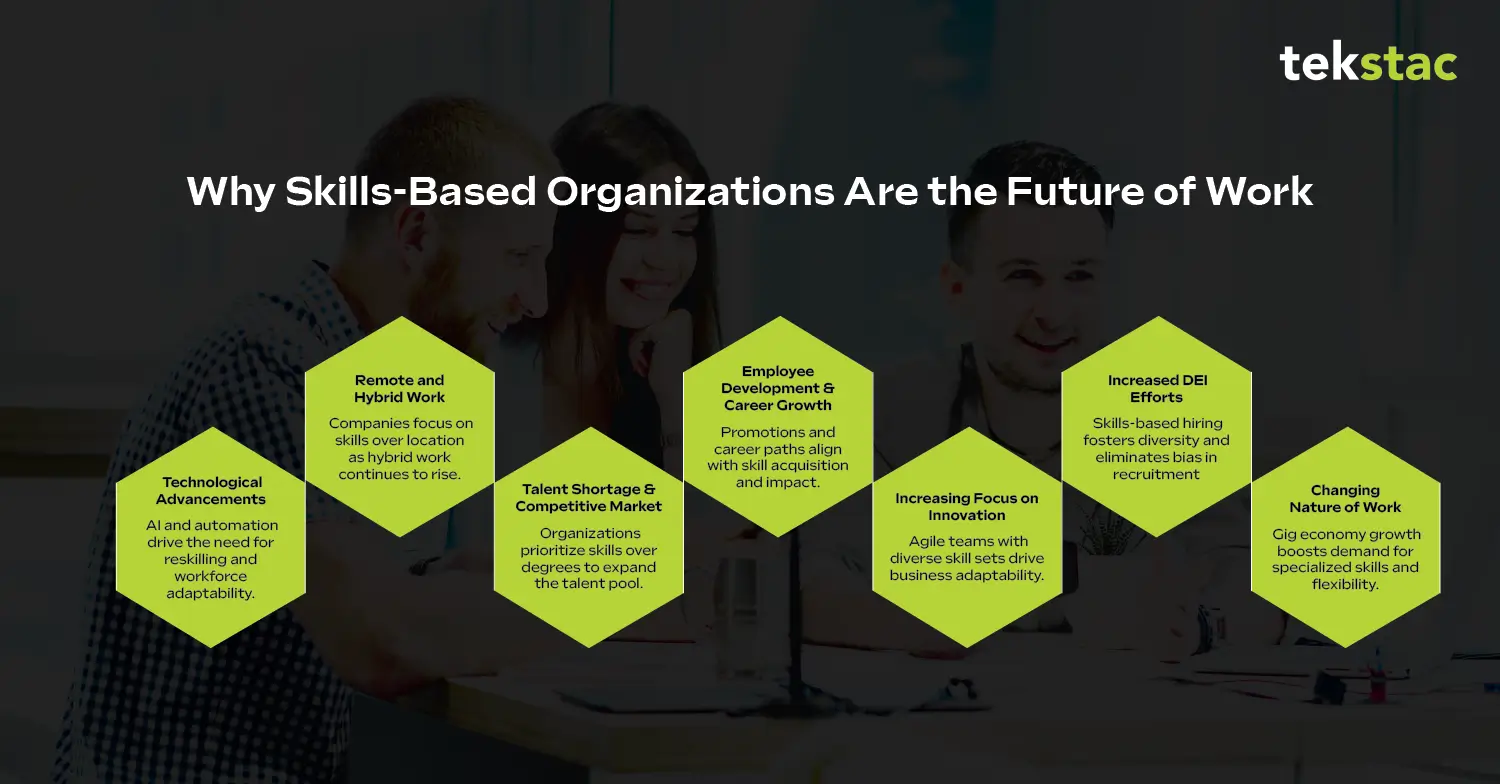
1. Technological advancements
Technology is rapidly changing industries, with businesses integrating automation, AI, and other digital tools into their operations. An IBM report found that India will be the biggest adopter of AI in 2024, with 59% of large IT organizations deploying AI and 27% exploring this technology. 74% of this group is actively using AI in the following areas:
- 67% for research and development
- 55% for reskilling and workforce development
- 53% for building proprietary AI solutions
With AI handling repetitive tasks, humans are needed for creativity and problem-solving. This has shifted the focus to specific skills employees need to work alongside these emerging technologies. Also, organizations increasingly use these technologies for reskilling and development, ensuring the workforce has the required skills and is ready for the tech-driven future.
AI is also being embedded into employee training programs, helping tailor learning experiences and provide real-time feedback, thereby accelerating the learning curve for both new hires and existing talent.
2. Remote and hybrid work
Since the pandemic, most organizations have shifted to remote work. However, at the end of 2024, remote and hybrid work is still on the rise and will continue in 2025. A report by JLL revealed that 90% of Indian organizations require employees to be present in the office 3 days a week, surpassing 85% of the global average. LinkedIn’s report on Global State of Remote and Hybrid Work shows a 4.6% increase in hybrid roles in India in 2024.
As people work from different locations, companies focus on the specific skills employees bring to the table, regardless of where they are.
3. Talent shortage and competitive labor market
As per a Manpower report, nearly 4 in 5 employers in India found difficulty in finding the right talent in 2024. As observed, a growing demand for skilled workers makes recruitment highly competitive. To attract and retain talent, organizations must drop formal educational requirements and leave behind factors like location, background, race, and so on to hire talent that aligns with organizational needs. This mindset will help tap into a broader talent pool and retain skilled employees.
4. Emphasis on employee development and career growth
A skills-based approach also promotes talent mobility by allowing employees to move laterally across departments or take on cross-functional roles based on their skills, not just tenure. This increases engagement and retention while unlocking hidden potential within the workforce.
With 55% implementing new technologies to reskill and support workforce development, the emphasis is moving away from career growth based on skills employees acquire and their ability to drive value. This means promotions, appraisals, and career paths will be tailored to individual skill sets and their impact on the organization.
5. Increasing focus on innovation
With the changing nature of work, companies now require teams that can adapt quickly to new needs. The need for agility and innovation has grown in response to market disruptions, such as global pandemics, economic shifts, and technological advancements. To quickly innovate, organizations must create flexible teams of employees with diverse and evolving skill sets to adapt to this fast environment.
6. Increased DEI efforts
HBR found that in 2024, organizations’ overall Diversity, Equity, and Inclusion (DEI) efforts had increased when compared to the previous year. A high 60% of organizations had a DEI strategy in 2024. Focusing on skills rather than background allows companies to improve and broaden their hiring criteria, removing biases related to educational background, race, or gender. This approach ensures that candidates are hired and promoted based on their abilities and potential.
7. Changing nature of work
During the festive season, India witnessed a 23% increase in gig employment opportunities compared to 2023. With work changing, more project-based, freelance, or contract roles will require specialized skills. With talent shortages and competition, companies may shift to gig employment to leverage talent for specific skills. This also allows for more flexible work arrangements and quicker scaling of specialized teams.
Adopting a Skills-Based Culture in 2025
As businesses continue to transform at a higher pace, adopting a skills-based culture is emerging as an essential factor for organizational adaptability and innovation in 2025 and beyond. This forward-thinking approach will allow companies to prioritize employee capabilities, even in the face of technological disruptions and workforce expectations.
Traditional models that still rely on rigid hierarchies, predefined job titles, and tenure-based career paths will continue to witness challenges in DEI, utilization of talent, work-life balance, skill development, and career growth.
Organizations must implement efficient systems to evaluate and track skills effectively to adopt and maintain a skills-based culture. This requires skills-based assessments that focus on:
- Capabilities and the potential to grow and adapt
- Dashboards, real-time analytics, and data-driven insights
- Targeting tracking to keep a pulse on skills progression, strengths, and development plans
To support this shift, organizations must refine their L&D strategy, making it more agile, data-driven, and aligned with evolving business needs.
Transform Learning into Business Impact
This is where Tekstac can step in for organizations, whether pre-hiring assessments, reskilling, upskilling, or career development for IT professionals. It offers a comprehensive curriculum that can be fully personalized to meet organizational needs, ensuring employees acquire the skills necessary to succeed. Its solutions go beyond theoretical training by providing the following:
- 300+ learning paths to choose from, including data analytics, cloud, etc.
- Customizable assessments for specific skill requirements
- Practice labs and exercises with real-world simulations and hands-on training
- Data-driven insights on individual progress to monitor learning outcomes
These tools integrate seamlessly into existing L&D strategies, transforming how employees learn and grow.
What is Microlearning? A Complete Guide to Boosting Employee Skills
How often have you been handed a lengthy PowerPoint deck for training and thought, When am I supposed to find time for this?
That’s where microlearning comes in. But what is microlearning exactly? It’s a modern learning method that delivers bite-sized, targeted lessons—perfect for busy employees adapting to changing work demands.
They take too much time, aren’t easy to retain, and can be dull.
That’s why microlearning is gaining popularity. It’s a more modern, efficient way of learning that focuses on bite-sized, targeted lessons designed to fit busy schedules. With today’s demanding employees mastering new tools and adapting to changing work environments, microlearning is the perfect solution!
What is Microlearning?
Microlearning is a method that breaks down learning into small, bite-sized modules. It helps employees to acquire skills quickly, effectively, and in a way that fits into their busy workdays.
These bite-sized modules are brief, spanning from a few minutes to 15 minutes. They can take various forms, including short videos, interactive quizzes, infographics, or quick-read articles—often accessible through digital platforms.
How Does Microlearning Work?
Microlearning begins with identifying a specific learning objective or a skill gaps. Instead of teaching a broad or complex topic all at once, it focuses on a single concept, skill, or task that needs immediate attention.
The learning journey is then broken into small, focused modules that can be completed independently. Each module builds upon the previous one (if necessary) or serves as a standalone unit. Learners can move at their own pace.
Each module concludes with a clear takeaway or action point. Learners are given a quick assessment to ensure they have grasped the material. This evaluation reinforces learning in applying the skill on the job.
How Microlearning Improves Employee Retention
Organizations have long struggled with employee retention, and one primary reason is the need for meaningful learning opportunities.
As per LinkedIn’s 2024 Workplace Learning Report, 90% of organizations are heavily concerned about employee retention and promote learning opportunities as their number one retention strategy.
Here are five ways how microlearning improves employee retention.
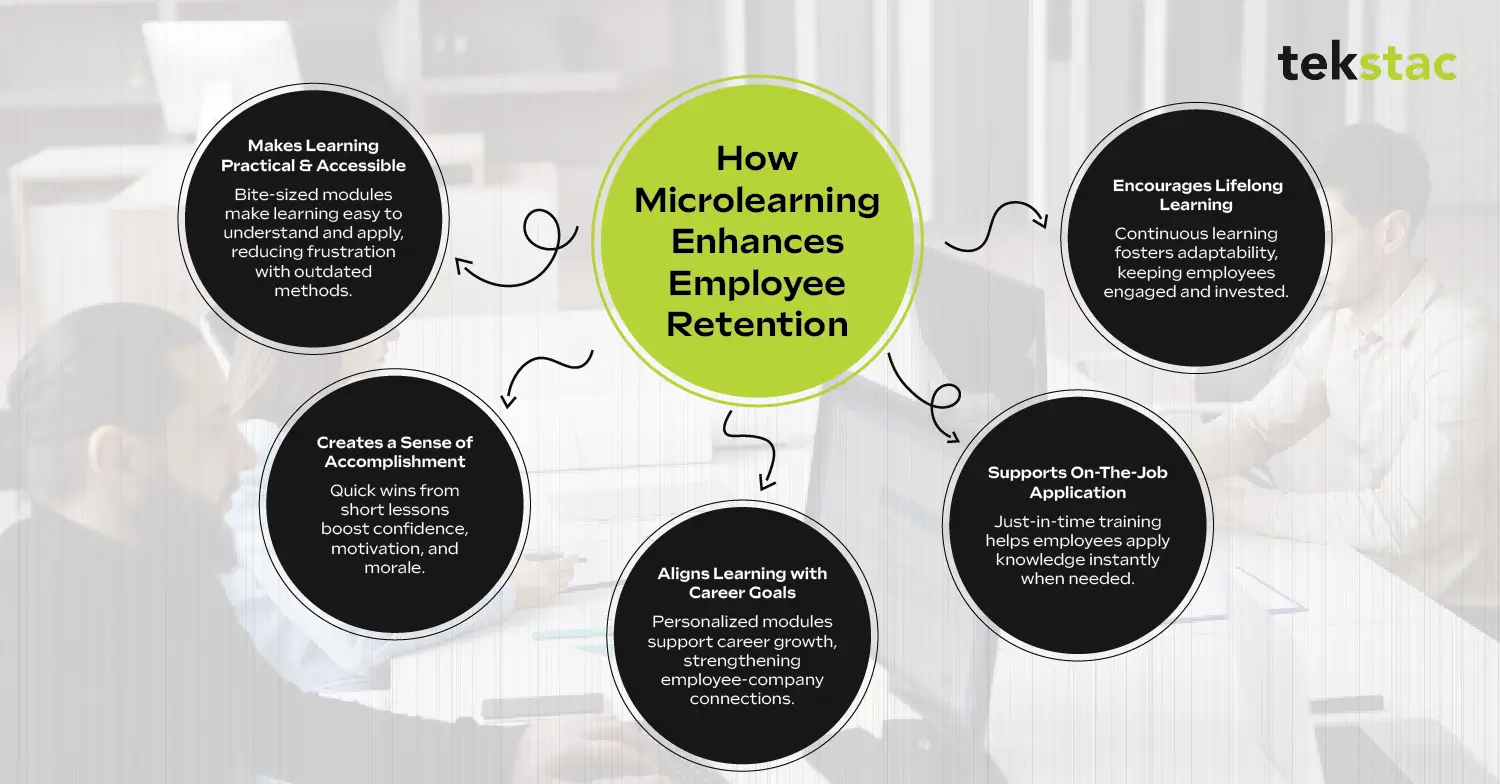
1. Makes Learning Practical and Accessible
Since microlearning breaks down topics into easily understandable modules, employees engage with the information positively and apply knowledge. This reduces frustration with outdated learning methods and shows employees that the organization values their time.
2. Creates a Sense of Accomplishment
When employees complete short, actionable lessons, they experience quick wins. With practical information, employees will begin to implement their learnings, also creating opportunities for achievements. This continued sense of progress motivates them to continue learning, improving morale and loyalty.
3. Aligns Learning With Career Goals
Microlearning focuses on designing personalized learning modules that directly support career progress. Employees are also more likely to participate in L&D programs, creating a stronger connection between the employee and the company. This also shows that the organization is invested in employee growth.
4. Supports On-The-Job Application
Microlearning delivers just-in-time training, providing employees with the exact information they need when they need it.
For example, imagine a sales representative preparing for a negotiation call. Instead of going through lengthy company manuals or attending a half-day workshop, they can quickly access a 5-minute microlearning module on effective negotiation techniques. This allows employees to apply what they’ve learned immediately.
5. Encourages Lifelong Learning
Traditional training programs sometimes operate on a “once-and-done” model, where employees undergo long sessions once or twice a year.
Microlearning emphasizes ongoing learning as an integral part of an employee’s work life. It ensures that employees constantly update their skills and knowledge without feeling overwhelmed. As a result, employees will stay with an organization as it creates a culture of growth and adaptability.
Microlearning Benefits for Employee Retention
Microlearning is a perfect learning method that appeals to the modern learner’s fast-paced work environment and suits the short attention span of the current generation. These bite-sized, goal-oriented modules offer the following five benefits:
1. Increases Knowledge Retention
When information is delivered in small, digestible chunks, employees can absorb and recall details more effectively than other methods. With higher retention rates, organizations will see a greater return on their learning and development investments as employees apply new skills more effectively. Employees also reduce cognitive overload and stress associated with information-heavy training programs.
2. Improves Employee Engagement
Since microlearning’s content is interactive or gamified with multimedia elements, it keeps learners engaged. Other extended training programs can feel monotonous, whereas microlearning is more enjoyable. Hence, companies will observe higher participation rates and lower training abandonment.
3. Faster Upskilling and Reskilling
Much has changed since the pandemic nearly five years ago. Every year, new skill set requirements keep evolving. Microlearning helps organizations quickly create or adapt learning content to address skill gaps per business needs. With quicker upskilling or reskilling, businesses can stay competitive and address skill gaps.
4. Enhances Employee Performance
Focused, job-specific microlearning content allows employees to learn and apply skills to their tasks quickly. This “just-in-time” learning improves on-the-job problem-solving.
For instance, The Journal of Applied Psychology found that leadership training alone can increase learning capacity by 25% and performance by 20%. These results show the impact of a well-designed training program on employee performance.
5. Creates a Culture of Learning
Microlearning’s flexibility and convenience allow employees to learn anytime, anywhere—promoting an ongoing learning habit rather than random training sessions. Organizations that promote continuous learning see better employee retention rates and attract top talent.
How to Get Started With Microlearning In Just 3 Steps
To get started with microlearning, organizations can take the following steps:
Step 1: Identify Key Learning Objectives and Skill Gaps
Conduct skills gap analysis to check for specific competencies employees need to develop. Collaborate with department stakeholders and team leaders to define the most critical knowledge areas aligning with organizational goals and workforce needs.
Once identified, map out the most essential learning objectives for microlearning content. This ensures that the training is relevant and addresses high-priority areas immediately.
Step 2: Create Short, Focused Content and Use Existing Resources
Develop microlearning modules that are at most 5-10 minutes each. Each module must focus on a topic or skill to allow employees to absorb information in a manageable size. Use existing training materials, videos, or tutorials as building blocks to reformat them into microlearning-friendly content. As always, ensure the content is interactive.
Step 3: Implement an L&D Platform and Measure Success
Adopt a platform that supports personalized, microlearning content. It should also offer advanced analytics to monitor learner progress, assess knowledge retention, and track how well learners are engaged.
Following the initiative’s deployment, analyze performance metrics to improve and optimize content and delivery methods. The platform’s real-time data and feedback loops or interventions can refine the learning experience.
What Are the Best Practices for Microlearning?
When a company embraces microlearning, it should be designed in a way that maximizes learning impact. The following best practices ensure that each learning module is purposefully designed for maximum employee performance:
1. Align Microlearning with Organizational and Industry Needs
Organizations must stay agile and aware of the changing world and required skills. This process involves regularly assessing industry trends, workforce demands, and future skills to ensure that the learning initiatives align with organizational goals and external market requirements. Regularly revisiting learning goals in response to changing needs is also essential.
2. Design for Application
Microlearning isn’t just about imparting information; it’s about making sure that the knowledge sticks and can be practically applied.
This requires a deliberate focus on retention techniques like spaced repetition. Employees should also be able to apply it to their daily tasks immediately. Use scenario-based learning or simulations to help them practice in a more realistic environment.
3. Personalize the Microlearning Experience
Not all employees learn at the same pace or have the exact needs. People retain information differently, and microlearning strategies should be flexible enough to meet these needs.
Personalization should include skill gaps, learning styles, and career goals. One way to quickly achieve this is to use learning data to create targeted training paths that focus on areas where employees need the most improvement.
4. Incorporate Multimedia for Engagement
Microlearning thrives when the content is visually engaging and diverse. Given the variety of learning preferences, some individuals may prefer visual learning, while others benefit more from auditory or hands-on methods. Make sure to blend videos, infographics, animations, and interactive elements. Consider polls, quizzes, and gamified components to make it more fun!
5. Ensure Accessibility Across Devices
Design content that is easily accessible on mobiles, tablets, or laptops. When employees can access training material on the go, between meetings or during a commute, it reduces barriers to participation. It fits into their busy schedules, allowing them to learn quickly. This on-demand learning ensures that training becomes a part of an employee’s workflow.
Empower Learning with Innovative Solutions
Organizations need tools that combine flexibility, scalability, and advanced analytics to achieve a smoother microlearning strategy. Such platforms must design content delivery with features like AI-driven personalization, real-time performance tracking, and assessments.
Look for solutions that integrate modular course creation, gamified learning paths, and detailed dashboards to design training that aligns with business goals. One such skilling solution is Tekstac, which supports these needs. It’s an ideal choice for organizations looking to transform their training or skill development initiatives for tech talent.
Talent Mobility Frameworks vs Career Pathing: Which Strategy Best Fits Your Organization?
Organizations are continuously working on ways to innovate, stay ahead of the competition, and adapt to market developments. Hence, the need of the hour is to tap into the full potential of employees by creating a culture of development, growth and mobility.
How can organizations adapt employee development? Talent Mobility Frameworks and Career Pathing are two approaches organizations take to promote employee career growth while meeting business goals and priorities.
Here’s an insight into what Talent Mobility Frameworks and Career Pathing are and how they can help your organization:
What is a Talent Mobility Framework and Why is it Important for Organizations?
A talent mobility framework is a strategic approach organizations take to help employees move across departments, roles, and projects in line with their career aspirations and meet business objectives.
By maintaining a talent mobility frameworks, organizations offer employees tools, resources, and processes that aid them in skill development, succession planning, and career progression. It encompasses internal transfers, cross-functional training, upskilling and reskilling, and internal transfers.
For example, Google offers an internal job board called “Google Jobs,” which showcases all the company’s open positions to its employees. It also provides career coaching and leadership development programs to facilitate employee transition into new roles. They also have a “gTwo” program that gives employees the opportunity to work in a different department or location.
What are the main components of a Talent Mobility Frameworks?
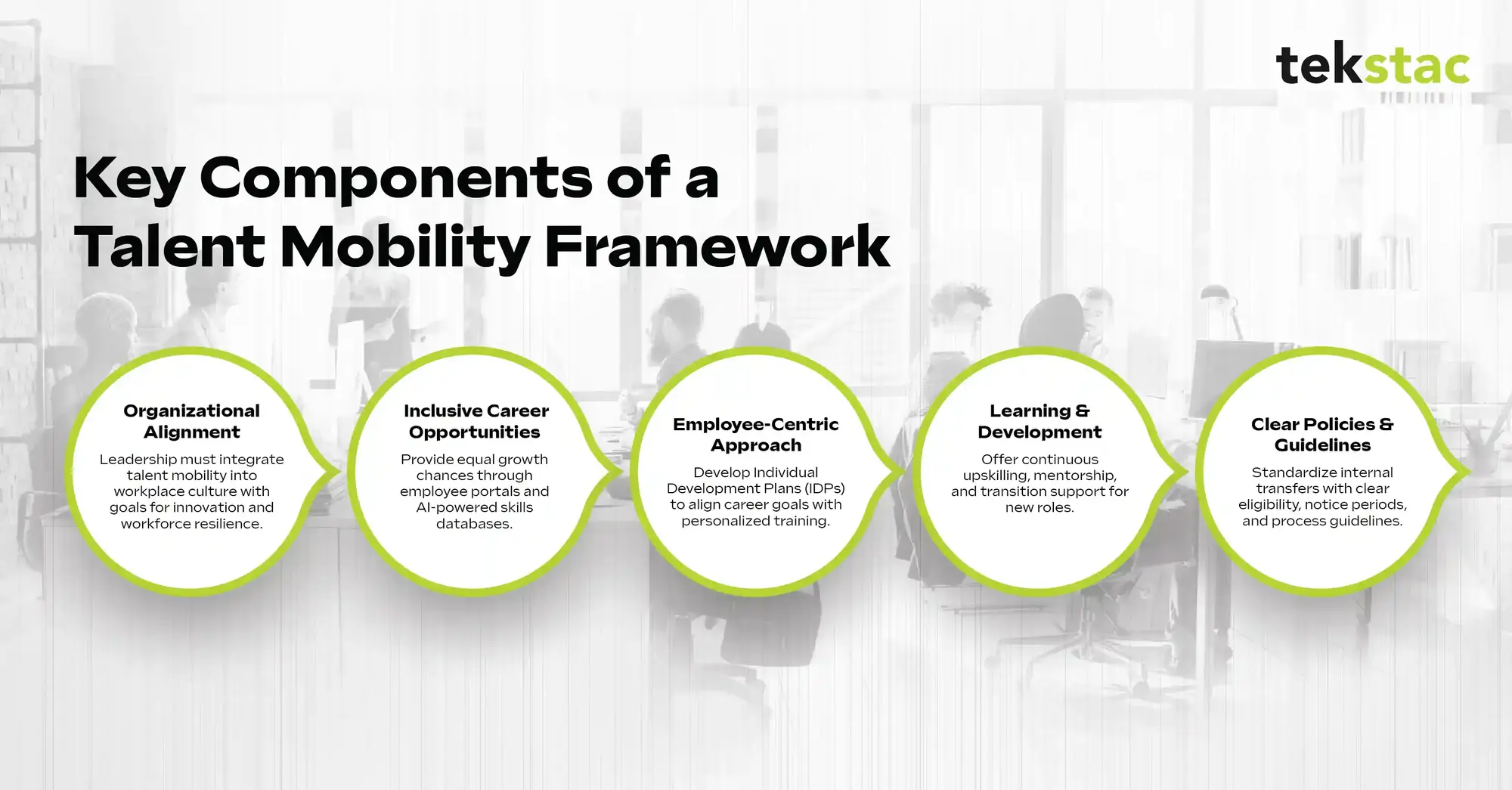
1. Being aligned with the organization
Leadership must prioritize and integrate a Talent Mobility Frameworks into the work culture. This framework should also have an end goal to be met regarding innovation, workforce resilience, and scalability.
2. Inclusive career opportunities
Organizations should offer employees equal chances to grow and facilitate this through internal systems like employee portals, where new posts, vacancies, and projects are posted. An AI-powered skills database also helps map employees’ roles in sync with their competencies and career goals.
3. Being employee-centric
HR must take steps to create Individual Development Plans (IDPs) to chart career plans with short-and long-term goals, identify skills or roles that the employee seeks, and offer training programs accordingly.
4. Learning and development
Through continuous learning and development, organizations must offer upskilling programs and mentorship to help employees transition into new roles and develop new competencies.
5. Setting policies
Establishing clear guidelines and standardizing processes (eligibility criteria, notice periods, etc) helps smooth internal transfers and project assignments.
Key Benefits of Implementing Talent Mobility Frameworks in Your Organization
Through a talent mobility frameworks, organizations can:
- Create an agile, diverse, and skilled workforce
- Retain top talent
- Enhance knowledge sharing
- Cut down time in employee onboarding
- Boost innovation and creativity
- Promote diversity and inclusion
What is Career Pathing and How Does it Drive Employee Growth?
Career pathing is a way for employees to fulfill their career aspirations by following a structured path, participating in developmental initiatives, reskilling or upskilling from time to time and meeting goals set by the organization.
Organizations can adapt career pathing to offer personalized learning, identify skills and competencies that support employees’ growth, and track their progress.
The two essential approaches to career pathing are:
- Career Ladder – Also known as a formalized career path, it offers a conventional route for promotions wherein employees progress linearly in a particular department or job function.
- Career Lattice—This offers a more flexible approach to employee movement within the organization, based on both lateral and vertical movement. Hence, it encourages developing cross-functional experience and freedom to shape professional growth.
For example, Nestlé has a Nestlé Academy program that offers personalized career development programs featuring job rotations and skill training. Through this program, employees can set clear career goals tracked through regular check-ins. Nestle also offers leadership development programs that help meet employee career aspirations and align with organizational growth strategy.
What are the key components of Career Pathing?
1. Rounding up business needs
Organizations must first understand their business requirements, growth trajectory and identify leadership and business-critical positions.
2. Identifying career goals
Working in sync with employees helps organizations set short-and long-term goals that match their aspirations and meet organizational objectives.
3. Setting up personalized career paths
Companies should set up 1:1 meetings to discuss their employees’ ambitions, interests, and values. Then, walk them through the skills and experience levels required to reach their career goals.
4. Building an employee development plan
It is important to create strategies for acquiring skills, which include training sessions, upskilling and reskilling, shadow sessions, assignments, and mentoring.
5. Continuous feedback system
Organizations must establish metrics to determine employee performance and hold one-on-one discussions to assess the initiatives’ effectiveness. To boost employee morale, organizations must reward significant progress or milestones with bonuses, salary hikes, or promotions.
Key Benefits of Career Pathing for Workforce Development
Through career pathing, organizations can:
- Enhance employee retention
- Aim to offer higher job satisfaction
- Achieve higher employee engagement
- Increase work productivity
- Attract top talent
- Improve employee-employer relationship
- Promotes a culture of continuous learning
Which is the right fit for your organization – Talent Mobility Frameworks or Career Pathing?
Both approaches are invaluable for an organization’s employee development and retention efforts. Choosing the right approach depends on your company’s culture, business requirements, and goals.
Talent Mobility Frameworks favor organizations focused on cross-functional learning, flexibility, and agility. If your main aim is to encourage employees to obtain diverse experiences and build versatile skills, moving across different departments, internal transfers, this approach would help immensely.
Career Pathing is more suitable for organizations that prefer structured and clear career progression. It is easier to implement in large or mid-sized companies with numerous hierarchical levels, which means moving to higher-level roles and retaining top-performing talent.
Organizations can also take a blended approach, ensuring flexible and structured growth. For example, employees can acquire diverse skill sets through cross-functional roles or lateral moves while working towards defined career goals.
For example – To get the best of both worlds, an organization can create a platform that offers internal job rotations, offshore assignments and short-term projects alongside well-defined career paths with specific milestones and development programs. This dual approach empowers employees with flexibility, helps them achieve long-term goals and create an agile workforce.
Whichever approach you choose, organizations can emerge as forward-thinking and keep reinventing themselves to stay relevant in a dynamic landscape.
FAQs on Talent Mobility Frameworks
1. How do Talent Mobility Frameworks benefit employee retention?
Talent Mobility Frameworks empower employees with growth opportunities within the organization, reducing the need to look elsewhere for career advancement. This increases engagement, job satisfaction, and long-term retention.
2. Can organizations implement both Career Pathing and Talent Mobility together?
Yes, combining structured Career Pathing with flexible Talent Mobility allows organizations to offer clear progression paths while encouraging diverse, cross-functional experiences, leading to a more agile and motivated workforce.
3. Why is internal talent mobility essential for future-ready organizations?
Internal talent mobility helps businesses quickly adapt to changing skill demands by reallocating existing talent, fostering workforce agility, and reducing hiring costs.
4. How does Career Pathing enhance employee engagement?
Career Pathing provides employees with a transparent growth roadmap, personalized development plans, and regular feedback, which boosts motivation and aligns individual aspirations with business objectives.
Workplace Learning Strategies: 5 Proven Tactics to Boost L&D Engagement
Why Traditional Training Is No Longer Enough for Workplace Learning
Traditional classroom training is fading fast. To stay competitive, companies must rethink how their teams learn and grow. Business leaders across industries report significant skill gaps in their workforce, making the evolution of learning programs a critical priority. The key challenge lies in creating engaging learning environments that effectively bridge the gap between theoretical knowledge and practical business applications.
Let’s explore five proven workplace learning strategies that empower learning and development (L&D) leaders to transform routine training into engaging, performance-driven workplace learning experiences.
- Create Immersive Practice Environments
- Put AI-Powered Personalization into Practice
- Integrate Learning into Daily Workflows
- Use Progress Tracking Driven by Data
- Encourage Collaborative Learning Environment
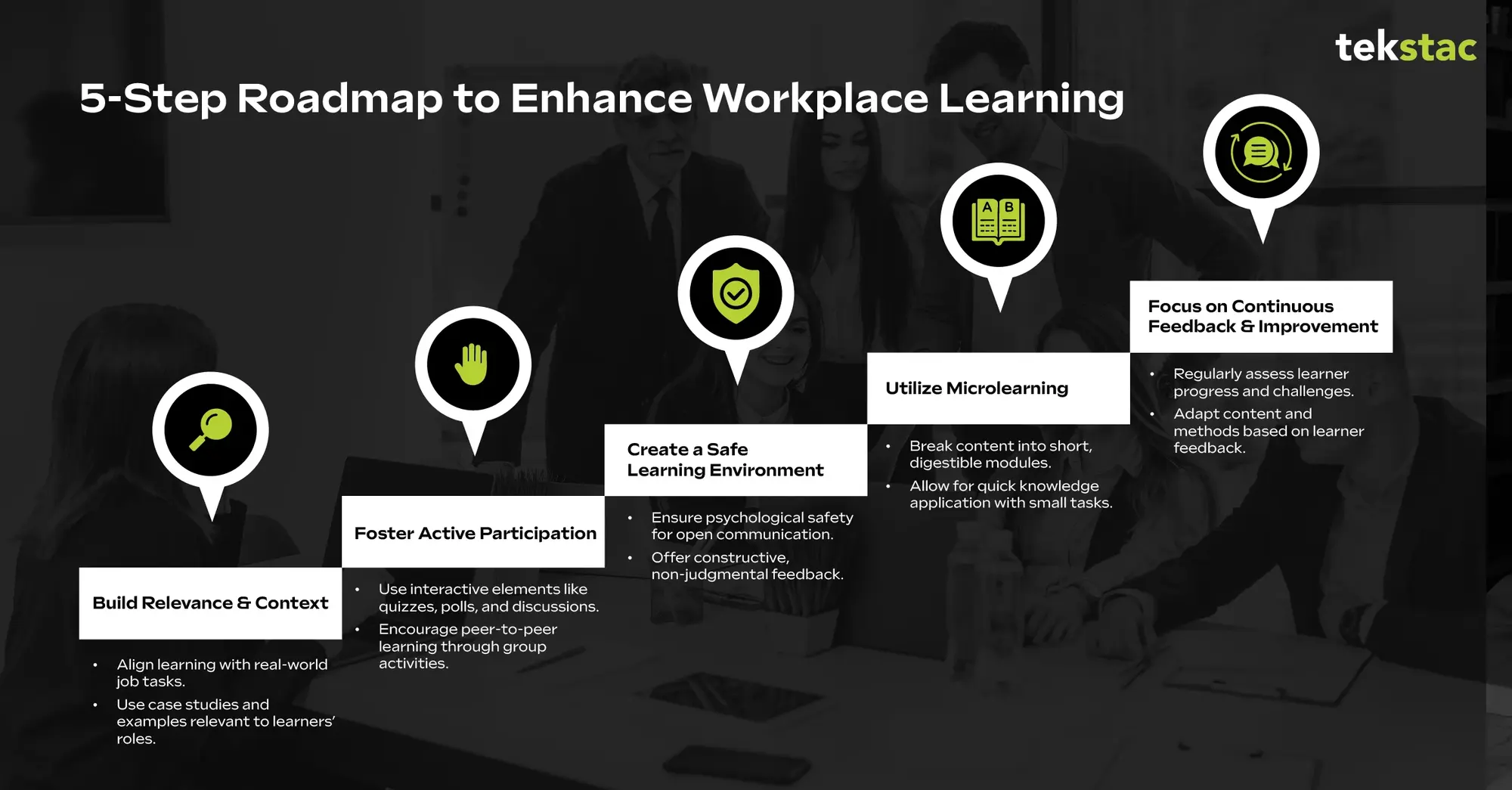
1. Create Immersive Practice Environments
The disconnect between theory and practice frequently causes poor skill memory. Companies that implement experiential learning programs enjoy a 55% higher rate of skill acquisition than those that use standard training techniques, says the Josh Bersin Company’s Corporate Learning Report 2024.
Look at these implementation techniques:
- Create sandbox settings where staff members can safely practice new abilities.
- Make scenario-based tasks that replicate actual work environments.
- Include tools for instant feedback to promote learning.
Professionals may practice everything from cloud infrastructure to programming languages in real-time with Tekstac’s integrated lab environment, for instance, guaranteeing that abilities translate seamlessly to real-world work situations.
2. Put AI-Powered Personalization into Practice
One-size-fits-all training plans are becoming obsolete. Learning in the modern workplace requires large-scale customization. IDC’s recent research shows that companies that use AI-driven learning systems see a 30% reduction in training time and a 45% increase in employee participation in development programs.
Among the components of effective personalization are:
- Utilizing computerized evaluations to analyze individual skills gap
- Developing personalized learning programs according to job specifications and professional objectives
- Changing the level of difficulty of the content according to student performance and progress
Making learning feel more like a customized path to mastery rather than a required task is crucial.
3. Integrate Learning into Daily Workflows
When workplace learning is smoothly incorporated into routine responsibilities, it is most successful. For example, a sales representative might access quick microlearning modules about new product features while updating their CRM entries, or a software developer could review code optimization techniques through integrated IDE plugins while writing code.
This method, which is frequently referred to as “learning in the flow of work,” enables staff members to apply newly acquired knowledge to actual problems right away.
Among the implementation techniques are:
- Dividing intricate subjects into modules for microlearning
- Supplying timely learning materials that are integrated into job tools
- Developing searchable knowledge bases and rapid reference guides
Organizations can improve engagement and knowledge retention by providing easy access to learning materials in real-world work scenarios.
4. Use Progress Tracking Driven by Data
Modern L&D leaders require quantitative and qualitative data to measure learning effectiveness. While data analytics dashboards track measurable outcomes like completion rates, skill assessments, and performance improvements, qualitative feedback through surveys and team leader observations helps evaluate behavioral changes and practical application of new skills
Dashboards for advanced analytics make it easier to monitor program impact as well as individual progress. Businesses that successfully use learning analytics report a 41% boost in employee productivity and a 53% increase in employee retention, according to research from Brandon Hall Group’s Learning Strategy Study.
Key metrics to track include:
- Time to competency for new skills
- Utilizing acquired abilities in practical projects
- effect on both individual and team performance
- Return on Learning Investment (ROLI)
Organizations may track these KPIs in real time with Tekstac’s extensive analytics dashboard, which aids L&D leaders in making data-driven choices regarding their educational initiatives.
5. Encourage Collaborative Learning Environment
Creating chances for peer learning and information sharing can greatly increase engagement, even though individual learning routes are still vital. According to the Enterprise Learning Annual Report 2024 by Fosway Group, 94% of L&D leaders now place a high priority on collaborative learning strategies, with peer-to-peer learning having the greatest influence on skill development.
Among the strategies for collaborative learning that work well are:
- Establishing mentor marketplaces to facilitate the exchange of expertise
- Setting up team-based learning challenges and hackathons
- Leading peer-to-peer educational activities
- Creating practice communities centered on particular skill sets
Transitioning: Execution Advice for Successful Workplace Education
It takes considerable preparation and execution to turn traditional training into engaging workplace learning. Employee expectations and corporate goals must be met by contemporary workplace learning solutions.
How do you implement learning in the workplace?
- Examine ongoing programs: Look for ways to add additional practical experience and real-world applicability to current training programs. To prioritize changes, find the gaps between industry best practices and present workplace learning processes.
- Begin Small: Before expanding the program throughout the entire company, start with a pilot project in a single team or department. This strategy enables you to improve workplace learning tools and techniques in response to immediate input and outcomes.
- Assess and Modify: Utilize learning analytics to monitor efficacy and engagement, then make modifications in light of data-driven insights. Pay attention to measures that show a clear link between workplace learning programs and company results.
- Get Input: Gather feedback from learners on a regular basis regarding their preferences and experiences to improve the teaching methodology. This ongoing feedback loop aids in maximizing the effectiveness of workplace learning tactics.
How to Overcome the Top Workplace Learning Challenges
Organizations frequently run across a number of challenges while implementing new learning methodologies.
Here’s how to deal with typical workplace learning obstacles:
1. Time Limitations
You can handle time constraints with the use of contemporary workplace learning technology by:
- Providing microlearning courses that accommodate hectic schedules
- Making mobile learning accessible for access while on the go
- Including learning materials in workflow tools at the right moment
2. Barriers to Engagement
Boost L&D involvement by:
- Features of gamification that increase interaction in learning
- Features of social learning that promote peer cooperation
- Recognition programs that honor academic success
3. Application of Skills
- Close the knowledge gap between application and learning by:
- Developing practice scenarios inspired by actual work environments
- Putting project-based learning opportunities into practice
- Putting mentorship programs in place to transmit knowledge
What the Future of Workplace Learning Looks Like
Workplace learning is the integration of continuous, personalized, and collaborative training directly into daily workflows. It enables employees to build skills faster, apply them immediately, and drive measurable business performance.
The capacity to provide effective, engaging learning experiences is becoming increasingly important as firms continue to navigate the rapid changes in technology. According to McKinsey’s latest State of Organizations Report, 87% of executives report existing or expected skills gap in their workforce, indicating that transforming learning programs is a top priority.
The age of static, one-size-fits-all training is over. Next-gen corporate learning is agile, personalized, and immersive.
Effective workplace learning programs will prioritize the following:
- Flexible learning programs that change to meet the needs of employees
- Incorporating cutting-edge technologies such as VR and AR
- Improved analytics to gauge the impact of learning
- Greater congruence between educational initiatives and corporate strategies
Beyond merely imparting knowledge, workplace learning aims to provide life-changing experiences that enable staff members to develop their abilities in the context of their regular jobs.
This strategy promotes corporate performance and personal growth by:
- Quickening the acquisition and mastery of skills
- Increasing employee retention by providing opportunities for advancement
- Increasing the resilience and adaptability of the workforce
- Encouragement of innovation and competitive advantage
Ready to Transform Your Learning Culture?
Effective workplace learning methods must be a top priority for firms if they want to remain competitive in today’s quickly changing business landscape. L&D leaders can establish learning environments that produce quantifiable business results by implementing the five strategies mentioned above and utilizing cutting-edge learning platforms like Tekstac.
Want to future-proof your workforce? Book a strategy session with Tekstac today and see how our workplace learning platform delivers results.
FAQs on Workplace Learning Strategy
1. What is the future of workplace learning?
The future is agile, immersive, and personalized, leveraging technologies like AI, VR, and AR, and aligning learning initiatives more closely with business strategy to foster innovation and adaptability.
2. How can companies get started with transforming workplace learning?
Start with pilot programs, gather feedback, track engagement and outcomes with analytics, and iteratively refine learning strategies to align with both employee and business needs.
3. What is the 80/20 rule for learning?
The 80/20 rule for learning means that 80% of results come from 20% of focused effort. In workplace learning, it highlights prioritizing the most valuable skills and training activities that drive the biggest performance impact.
4. How does workplace learning impact employee engagement?
Engaging workplace learning links skill development directly to daily tasks, making employees feel more competent, confident, and connected to business outcomes.
How Inclusive Leadership Drives Effective Upskilling and Reskilling Programs
Over the next few years, more than 50% of the world’s workforce will need to develop or improve upon skills in order to remain competitive amidst technological and economic changes.
Unfortunately, the majority of organizations relegate reskilling and upskilling to one of many roles that fall upon HR, with only 13% including other managers in the development of these programs. However, prioritizing Inclusive Leadership is crucial—when only HR is in charge, it often lacks the specific knowledge of a team’s unique needs or challenges. This risks you designing learning programs that don’t align with real-world requirements or resonate with your employees. By embedding Inclusive Leadership into skills development, organizations can ensure their reskilling efforts are both relevant and impactful for every team member.
There’s a better way—by incorporating all leaders and fostering a culture of inclusive leadership, your reskilling and upskilling programs will not just grow workers’ skills, but will meet each employee’s individual needs.
What is Inclusive Leadership?
Inclusive leadership is the process of company leaders empowering employees and valuing diverse perspectives. An inclusive leader can cultivate a culture full of trust and collaboration if they are open to new ideas and inclusive of all backgrounds.
This often shows up in the form of a commitment to diversity initiatives, a focus on collaborative decision making, and a culture of empathy and psychological safety. For example, this may include leaders establishing and advising employee resource groups or driving feedback sessions to amplify underrepresented voices.
To foster a culture of inclusive leadership, survey employees to understand their needs and goals. Remain open to—and solicit—continuous feedback with an eye toward iteration and improvement. Incorporate diversity and inclusion into company trainings and initiatives.
Why Inclusive Leadership Is Essential for Upskilling and Reskilling
Upskilling and reskilling are both essential to addressing the skills gap, but they are not the same thing. Upskilling refers to improving the skills one already holds, leading to better performance in a current position. Reskilling means providing employees with new skills that may enable them to take on an entirely new role.
Both reskilling and upskilling are paramount for companies hoping to grow amidst technological advances and a changing workforce. Whether that means teaching your team to leverage new AI technologies or helping them bolster their existing technical expertise, this type of retraining can keep your employees adaptable and engaged while driving toward company goals.
However, in addition to many companies lacking a focus on these programs, there may be other barriers. For instance, some employees may feel such programs interfere with their work time, while others may find them inaccessible due to logistical or language barriers. Focusing on inclusive leadership can remove these barriers.
How Inclusive Leadership Drives Successful Upskilling and Reskilling Programs
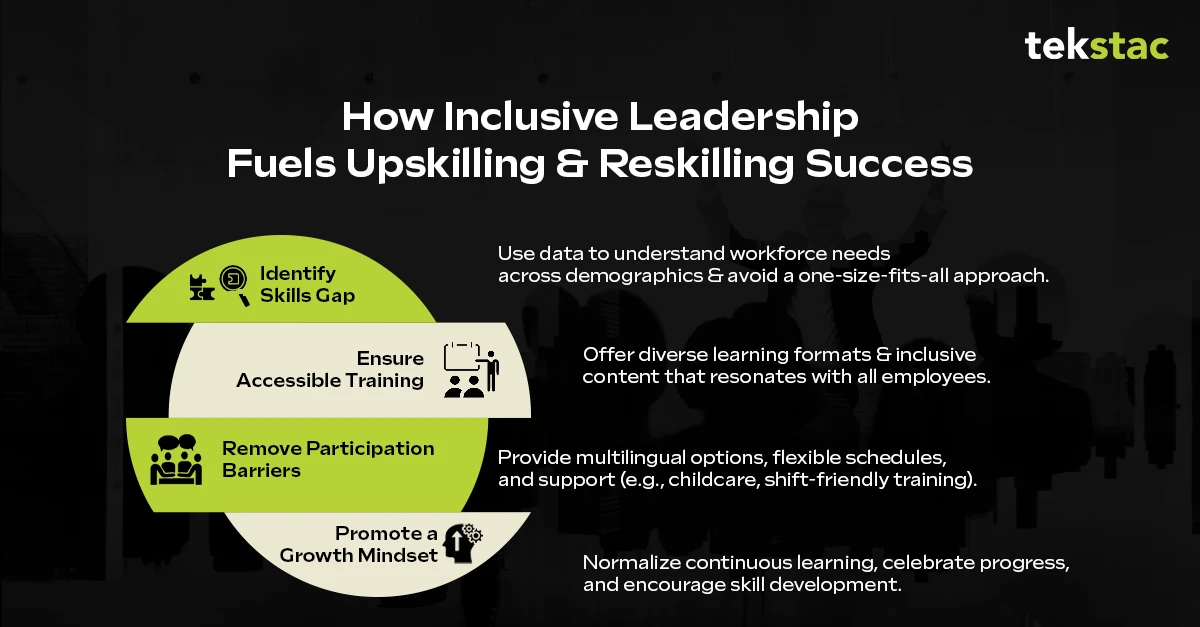
Inclusive leadership can contribute to successful retraining programs in several ways.
- Uncover skills gap across demographics: Leverage data to gain an unbiased look into the needs of different employee demographics, which will help you avoid designing training programs that are meant to be one-size-fits-all, and instead focus on meeting each group’s needs with engaging content.
- Create accessible programming: Tailor your programs’ content so it’s inclusive of your entire employee base, rather than appealing to only the majority. Be sure to deliver training in a variety of formats to ensure everyone can access the information they need in the way that’s best for them.
- Remove barriers: Consider where you can mitigate challenges to employee participation. For example, multilingual employees may do better with training in their primary language. Parents may require childcare coverage to attend certain training sessions, while shift workers may need courses offered outside of standard business hours. A best practice is to engage the affected groups to understand how to meet their needs.
- Foster a growth mindset: Make upskilling and reskilling a normal part of the organization’s culture, showcasing it as an opportunity for continuous learning. Acknowledge and celebrate participation in the programs.
As leaders prove their commitment to inclusion, they’ll inspire employee trust, making workers more likely to see the benefit of and engage in learning opportunities. Plus, the more a culture fosters the inclusion of new viewpoints, the more everyone can learn from each other. This can also lead to more innovative training and development approaches, like gamification or training led by subject-matter-expert peers.
Measuring the Impact of Inclusive Leadership on Upskilling and Reskilling
To stay aware of your progress, keep an eye on metrics like employee participation across various demographics, employee engagement scores (which can also be analyzed by demographic), and how well performance or promotion rates improve after the training sessions.
Combined, these metrics will paint a picture of how included your employees feel and how beneficial the upskilling or reskilling courses are, ensuring the programs equitably benefit all demographics and allowing you to discover and resolve any gaps. Consider using a comprehensive learning platform that tracks this data and provides insight into the ROI of your training programs.
Over time, upskilling or reskilling programs led by inclusive leadership practices should result in a stronger talent base with a better pipeline for new or higher-level roles, which should also position you with a higher competitive advantage against competitors.
How Inclusive Leadership Transforms Workforce Skills and Engagement
As the working world transforms with the continuous advent of new technology, your company must change along with it. One of the surest ways to stay competitive in a changing landscape is through a continued focus on upskilling and reskilling of employees.
However, trying to create a single program that meets every worker’s needs is likely to result in barriers and low adoption. Inclusive leadership is the answer. By striving to understand the needs of diverse demographics and design programs that meet each employee where they are, you’ll break down barriers, increase participation, and future-proof your team.
If you’re an inclusive leader looking to get started with upskilling and reskilling, check out a Tekstac demo. With 500+ unique learning paths and assessments, there’s a way to meet every employee’s skill development needs.
Inclusive Leadership on FAQs
1. What is the difference between inclusive leadership and transformational leadership?
Inclusive leadership focuses on diversity, equity, and ensuring every voice is heard. Transformational leadership inspires and motivates teams to achieve vision-driven goals.
2. Why is inclusive leadership important in the workplace?
It drives diversity, innovation, and employee engagement by creating a culture where everyone feels valued, boosting collaboration and business performance.
3. What are the most important traits of an inclusive leader?
Inclusive leaders show empathy, practice active listening, embrace cultural awareness, ensure fairness, and foster an environment where all voices are respected.
4. How do you measure inclusive leadership in an organization?
It can be measured through employee surveys, 360-degree feedback, and diversity metrics, along with tracking engagement, retention, and representation rates.
7 Steps to Cultivate a Willingness to Learn in the Workplace
What Is Willingness to Learn and Why It Matters at Work
The workplace is undergoing a profound transformation. Artificial intelligence is streamlining routine tasks, remote work is reshaping team dynamics, and industries are evolving at an unprecedented pace. In this rapidly changing environment, one trait has become indispensable for both employees and organizations: the willingness to learn. Embracing continuous learning is no longer optional; it is the key to thriving in an ever-adaptive world.
Willingness to learn is the proactive attitude and openness individuals demonstrate toward acquiring new knowledge, skills, or behaviors to grow personally and professionally. It reflects adaptability, curiosity, and a commitment to continuous improvement in any setting.
In other words, it is the concept of wanting to expand, evolve, and find ways to solve new issues. For businesses, it means creating teams that don’t only respond to change but also get ready for it. For employees, it’s the key to staying competent in a constantly changing working landscape.
Importance of Willingness to Learn in the Workplace
Organizations without a learning culture risk falling behind in the competitive market. According to the Workplace Learning report 90% of organizations are concerned about employee retention, and providing learning opportunities is the No. 1 retention strategy. Additionally, 7 in 10 employees say learning improves their sense of connection to their organization, and 8 out of 10 employees say learning adds purpose to their work.
These statistics highlight the importance of a robust learning culture that promotes employee involvement and organizational sustainability.
7 Effective Ways to Foster Willingness to Learn in the Workplace
This article will help you understand the ways to encourage learning in the workplace and show you seven key steps to start.

Step 1: Establish Specific Learning Objectives and Goals
Setting definite, well-defined goals is a crucial first step in developing a culture of learning. Learning objectives provide people with a feeling of direction and ensure that their efforts are in line with the organization’s and the employees’ demands. Training initiatives may not be successful without these objectives.
Specific issues, such as filling up technical skill gaps, training staff for future leadership positions, or enhancing teamwork, can be addressed by clearly defined learning objectives.
An IT corporation might recognize, for example, that the market lacks cybersecurity expertise. Within the next six months, it aims to train half of its staff in advanced cybersecurity techniques to tackle this challenge.
It makes objectives more attainable by making them more precise and quantifiable. Rather than trying to “improve skills,” businesses can concentrate on specific results. Measurable goals make it simple for people to monitor their progress.
Practical tip: Share learning objectives with your group. Everyone in this situation is aware of how their growth contributes to the success of the company. Review these objectives frequently to make necessary adjustments as priorities change. You can utilize a skills development platform like Tekstac to ascertain the employees’ present skill levels, pinpoint any gaps, and create customized learning paths for them.
Step 2: Evaluate Your Current Learning Culture
Prior to establishing a learning-focused workplace, it is important to know where you are beginning.
Finding weaknesses, obstacles, and areas for development is made easier by evaluating your current learning culture. This phase lays the groundwork for developing a plan that appeals to staff members and promotes significant change.
Start by using data analysis, interviews, and questionnaires to get employee input. This method gives a clear picture of the learning environment in your company by fusing quantitative data with qualitative observations.
Pose queries that reveal attitudes as well as real-world difficulties, such as
- “Do you feel the organization supports your professional growth?”
- “Are training materials interesting and pertinent?”
- “Do you have enough time to engage in learning activities during the workday?”
- “How simple is it to access learning platforms or training materials?”
Once this data has been gathered, search for trends.
Employees might complain, for instance, that learning resources are difficult to locate, training programs are too general, or the content isn’t interesting. These revelations highlight obstacles that could deter involvement and impede advancement.
Engage team leaders in this evaluation procedure as a practical tip. Their observations can highlight challenges and opportunities for development unique to a department. Additionally, conduct this assessment regularly to ensure that modifications meet the demands of the company and its employees.
Practical tip: Engage team leaders in this evaluation procedure. Their observations can highlight challenges and opportunities for development unique to a department. Additionally, conduct this assessment regularly to ensure that modifications meet the demands of the firm and its employees.
Step 3: Build an Action Plan That Aligns Learning with Career Development
After evaluating your present learning culture, it’s time to take action based on your findings.
A well-thought-out plan turns employee input into focused projects that meet organizational requirements and complement company objectives. Such a strategy ensures that learning occurs and has a significant influence on both personal development and corporate success.
Prioritize the results of your assessment first. For instance, if staff members express low levels of engagement, think about implementing microlearning sessions or gamified learning modules that are convenient for their hectic schedules.
Managers should concentrate on developing focused initiatives to overcome any significant skill shortages they find. Workshops on leadership development, for example, might equip aspiring leaders to take on more responsibility. Teams can stay ahead of the curve in rapidly changing domains like cybersecurity or artificial intelligence with customized technical training.
Pro Tip: Prioritize development topics according to their influence on corporate goals by using advanced analytics to pinpoint specific skill gaps. Tailored programs that match staff development with corporate requirements can be developed with the aid of customizable learning pathways.
Step 4: Make Learning Accessible
Accessibility is a must for learning to succeed in the workplace. Obstacles such as scarce resources or cumbersome platforms may deter workers from taking part in the educational programs.
Employees may integrate training into their workdays without interruption thanks to on-demand learning modules, which let them access content whenever it’s convenient for them.
Mobile-friendly solutions may make learning resources always accessible for remote or hybrid teams, regardless of whether workers are at home, in the office, or on the go.
Models of blended learning are another successful strategy. When employees gain from both the interpersonal engagement of in-person encounters and virtual learning, they combine online training with in-person meetings.
Employee participation is positively correlated with the ease of learning. Eliminating barriers such as confusing systems or complicated content produces a smooth experience that encourages participation.
Practical Example: The corporation implemented a mobile-friendly learning platform with brief, interactive courses as part of its shift to a remote work model. Workers may finish training at their own pace, which would increase engagement and reduce skill retention.
Step 5: Recognize Learning Efforts
Fostering a culture of continuous development requires acknowledging employees’ learning accomplishments.
Practical Ways to Recognize Learning Efforts
- Public Recognition: During team meetings or in corporate communications, highlight the learning milestones of your staff. Celebrating the successful completion of a difficult course, for instance, can raise spirits and inspire others to seek out new chances for education.
- Digital Certifications and Badges: Put in place mechanisms that grant digital certifications or badges to students who complete courses. These can be shared on professional networks and act as representations of success.
- Rewards: Reward noteworthy learning accomplishments with bonuses, gift cards, or more paid time off. Customizing rewards to each person’s preferences can increase the significance of acknowledgment.
To recognize staff members who actively participated in learning, a manufacturing company instituted a “Top Learner of the Month” award. Employees were inspired to take part in training sessions since it fostered a culture of competition.
Pro Tip: Financial compensation isn’t the only method to show appreciation. An employee’s motivation and dedication to learning can be greatly increased by small actions like a shoutout during a team meeting or a handwritten thank-you email.
Step 6: Establish a Collaborative Learning Environment
Knowledge-sharing becomes a natural aspect of everyday work in a collaborative learning environment, also promoting a sense of community.
One essential component of collaborative learning is mentoring programs. Using a buddy system to pair seasoned workers with recent hires improves working relationships and speeds up onboarding outcomes. Mentors hone their leadership abilities while new hires acquire insightful knowledge.
Real-World Examples
- Buddy System: During onboarding, a marketing team matches new hires with more experienced team members. The buddy serves as a resource for inquiries, offers advice on procedures, and offers success advice.
- Lunch & Learns: A finance team organizes monthly meetings where staff members give presentations on subjects like market trends or budgeting tools. These unofficial gatherings encourage interaction between departments and provide a secure environment for knowledge exchange.
Pro Tip: Formal instruction is not necessary for collaborative learning. Even in remote or hybrid environments, platforms with peer-reviewed assignments or discussion forums can facilitate connections, idea sharing, and feedback among staff members.
Step 7: Measure Progress and Iterate
The success of any learning initiative lies in its measurable impact. Without tracking progress, it’s impossible to know what’s working or where improvements are needed.
To evaluate the success of your training initiatives and make sure they are in line with corporate objectives, set up explicit KPIs.
Pro Tip: Establish a feedback loop in which employee inputs help to improve learning programs. Iteration is an ongoing procedure.
This procedure can be made smooth with the use of sophisticated analytics tools. By providing comprehensive reports on completion rates, skill growth, and learner satisfaction, platforms such as Tekstac assist enterprises in tracking learning results in real-time.
Measuring the Impact of Willingness to Learn
- How many workers complete the programs they are assigned? Effective engagement is indicated by high completion rates.
- Improvement in Performance Following Training: Are workers successfully utilizing their newly acquired abilities in their positions? Check for increases in productivity improvement or project outcomes.
- Employee input: To discover more about learning satisfaction, conduct focus group discussions or surveys. Inquiries such as “Did the training meet your needs?” and “What could be improved?” provide insightful advice.
Your learning algorithms will stay relevant if you iterate based on this data.
For instance, HubSpot revamped its leadership training after employee feedback showed a need for more practical, role-specific development. Through their “Pipeline Program,” launched in 2021, they created targeted tracks for different leadership levels, combining hands-on projects with peer learning groups.
According to Katie Burke, HubSpot’s Chief People Officer, the program led to a 20% increase in internal promotions to leadership positions and helped the company achieve a 92% employee satisfaction score with management training.
Benefits of Cultivating a culture of Willingness to Learn
Investing in a culture of learning pays off in more ways than one:
- Employees feel valued when their growth is prioritized, leading to greater workplace loyalty.
- Teams equipped to learn and grow are better prepared to navigate change and solve complex problems.
- Organizations that foster continuous learning are more resilient and competitive in dynamic markets.
The future belongs to those who learn. Start building a culture that prioritizes growth and adaptability today. Explore how Tekstac’s tools and expertise can help you create a workforce that’s ready for the challenges of tomorrow.
FAQs on Willingness to Learn
1. Is willingness to learn a skill?
Yes, willingness to learn is considered a soft skill that shows adaptability, curiosity, and openness to continuous improvement.
2. How do you demonstrate willingness to learn?
You demonstrate willingness to learn by asking questions, seeking feedback, taking training seriously, adapting quickly, and applying new skills to tasks.
3. Why is willingness to learn important in the workplace?
It helps employees adapt to change, stay competitive, and grow in their careers while enabling organizations to innovate and retain talent.
4. What are examples of willingness to learn at work?
Examples include joining workshops, upskilling through online courses, volunteering for new projects, and practicing new tools or techniques in daily tasks.
Talent Density: What It Means and Why It Matters for Every Organization
The world of work is buzzing with changes!
Generative AI and automation are redefining recruitment with tools that draft job descriptions instantly, assess candidates for cultural fit, and even onboard employees. At the same time, skills-based hiring is replacing degree-focused approaches, driven by AI assessments. Meanwhile, employee experience platforms equipped with predictive analytics are helping HR teams personalize engagement strategies in remote and hybrid workplaces.
It’s HR that’s steering the future of the workplace through these massive changes.
Understanding Talent Density in the Modern Workplace
Amidst all this chaos, there’s a relevant and vital HR practice now more than ever—talent density—which focuses on creating small, high-performing teams. With a new era of work, companies now realize that success lies in maximizing the quality and capability of each team member.
Also, as we look toward 2026, we cannot deny that organizations will continue to face constant changes. In this blog, let’s discuss the essentials of talent density in 2026 so you can adapt.
What is Talent Density? Definition, Importance & Workplace Impact
Talent density is the concentration of highly skilled and high-performing employees within a team or organization.
You might think, “Don’t organizations already hire high-performing talent?” If they already prioritize hiring top performers, why would talent density even be an issue?
In practice, companies might hire underperformers unintentionally due to rushed hiring decisions or job requirements that aren’t aligned. As organizations grow, it’s easy to bring in candidates who may need to fully align with the company’s culture, resulting in a lower talent density.
Even a few underperformers can drag the team down, as their lack of contributions affects team performance. Additionally, the team must work collectively to be most effective.
How Talent Density Evolved: From Netflix to Global Workplaces
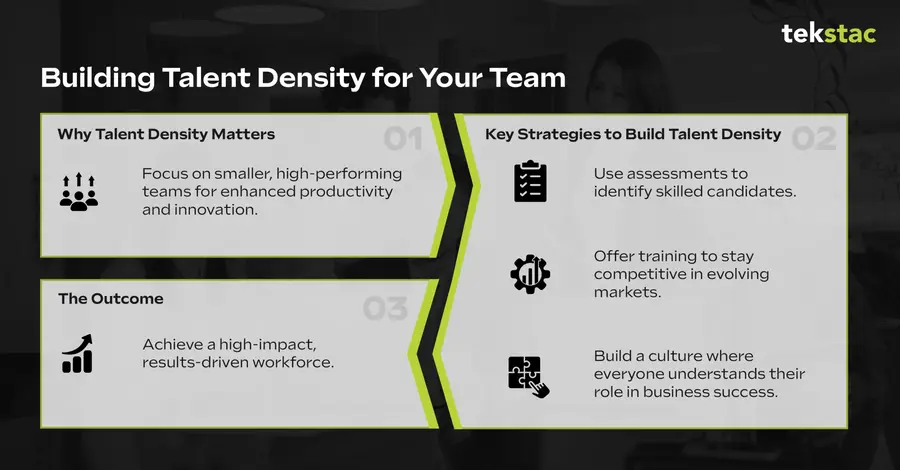
The concept of talent density originated with Netflix, which focused on building high-performing teams with fewer (but exceptional) people. In the book, “No Rules: Netflix and the Culture of Reinvention,” Reed Hastings, Netflix’s CEO, described talent density as a core principle that allowed the company to achieve remarkable results and innovation.
The foundation of talent density as a concept can be traced to studies on team dynamics, where it was observed that smaller, talent-dense teams outperform larger, less-skilled ones.
Soon, talent density gained traction with some skepticism due to its impact on culture, employee pressure, and mental health. However, as Netflix’s case studies became widely known, organizations began considering this approach.
However, the numerous shifts that changed the way we work turned talent density into a mainstream strategy. It will continue to be so in 2026, and let’s explore why.
Why Talent Density Will Be a Key Trend in 2026
Let’s look at the top 6 reasons why talent density will be a key trend in 2026:
- Shift towards smaller, high-impact teams
- Economic pressures and layoffs
- The growing impact of AI and automation
- Increase in skill shortages and reskilling initiatives
- Demand for innovation and adaptability
- Alignment with employee development
1. Shift towards smaller, high-impact teams
Gone are the days where only a fraction of members drive team performance. Organizations are increasingly adopting lean, high-impact teams to stay innovative.
For example, Spotify’s famous “squad model” consists of small, highly skilled employees with diverse expertise to work on specific projects or goals.
The gig work market is expected to triple by 2032, reaching $1,847 billion. With this traction, companies are assembling specialized teams for short-term, high-stakes projects. Hence, in the coming years, such cross-functional teams will become the norm, with a focus on creating highly talent-dense teams.
2. Economic pressures and layoffs
Tight budgets and rising costs force companies to achieve more with fewer resources. The effects of inflation and recession fears have led to record layoffs, especially in the tech and retail sectors. Amazon, for example, laid off over 27,000 employees but maintained focus on its core operations.
The tech industry has also seen around 150,000 job cuts in major corporations.
If global economies remain unstable, organizations will further rely on fewer but talent-dense employees. Failure to adapt can result in financial impact or inadequate cost structures.
3. The growing impact of AI and automation
AI has replaced repetitive tasks, requiring human workers to focus on creativity, strategy, and problem-solving. Higher talent density ensures that teams complement these technologies.
In fact, according to McKinsey & Company, around 72% of businesses will have used AI in at least one business function in 2024.
AI’s global deployment and exploration rates are close, at 42% and 40%, respectively.
With new technologies, AI tools will further disrupt traditional roles—and by 2026, these advancements will amplify this trend. Organizations will have to maintain high-performing teams that can adapt and manage to innovate alongside these tools.
4. Increase in skill shortages and reskilling initiatives
With new technologies, skills gap are widening as industries are evolving faster than education systems can adapt.
The demand for specialized skills will outrun supply, increasing the competition for top talent. According to Korn Ferry, in five years, there will be an $8.5 trillion talent shortage due to a lack of skilled talent. As of 2024, the US labor shortage was 70%, as employers could not find suitable candidates.
With reskilling programs, businesses can stay caught up. High-density talent ensures businesses have the right expertise to be competitive.
5. Demand for innovation and adaptability
Companies such as Disney and others in entertainment, finance, and healthcare industries are experiencing digital shifts. This forces them to innovate faster, requiring highly adaptable teams. Otherwise, organizations may lack the creativity or speed to compete and have the chance to become obsolete.
6. Alignment with employee development
Another critical reason for this is the expectation among employees for career growth and skill development. High density talent creation is in support of these expectations, bringing a mutually beneficial cycle about. As Gen Z comprises an increasingly larger proportion of the workforce, the development opportunities will also be growing. Failure to adapt means high turnover and a rather weak talent pipeline.
How to Build a Talent Dense Organization
With the speed at which the workplace is evolving, organizations are experiencing cut-throat competition for top talent—and if you’re not adapting, you’re falling behind. So, how do you build high-performing teams where everyone impacts team performance positively?
1. Nail Down the Roles That Truly Matter
Figure out which roles are make-or-break for your team’s success. Let’s say your team focuses on launching digital products. Instead of hiring generalists, zero in on product managers who live and breathe agile frameworks or UX designers with a great portfolio. Write job descriptions that attract those exact skills.
2. Make Pre-Hiring Assessments a Priority
Avoid guesswork, and instead use pre-hiring assessments to evaluate skills without bias. For instance, you can consider platforms like Tekstac to use coding challenges to dig into how candidates think and solve problems.
3. Go Small to Go Big
Big teams sound impressive, but small, high-performing teams are more impactful. They’re fast, flexible, and innovate for the right challenges, as the right people are placed in the right roles. They must be supported by the right culture where each individual recognizes their role in driving business outcomes.
For example, consider that you’re building a team to launch a new AI-powered product. You would need a lean, high-impact team targeting roles like:
- AI engineer with strong experience in machine learning frameworks
- Product manager who can adapt with his methodologies
- UX designer skilled in user-centric interfaces
Instead of relying on resumes, run targeted assessments to test coding and problem-solving skills. You can set up a quick design challenge for a UX designer, like creating a user-friendly prototype for an AI chatbot. Once hired, provide them with training with emerging tools, workshops, or certifications on AI product lifecycle. Lastly, make sure to set clear goals to tie their work to the bigger picture.
Conclusion: Building Talent-Dense Teams for the Future
Ready to build a high-performing tech team? Let Tekstac’s assessments guide you in finding and managing the high-performing talent your organization needs in 2026 and beyond. Get started today.
FAQs on Talent Density
1. How does talent density impact employee performance?
Talent density creates an environment where high-skill employees push each other to perform better, reducing drag from low performers. It boosts innovation, accountability, and problem-solving because every role is filled by someone capable of delivering impact. For HR and L&D leaders, it means fewer resources wasted and stronger performance per headcount.
2. What are the benefits of small, talent-dense teams?
Small, talent-dense teams move faster, make decisions quicker, and adapt to change with less friction. They reduce managerial overhead and enable deeper collaboration across functions. For HR, this structure improves productivity; for L&D, it ensures development investments go to people who drive measurable value.
3. How do companies measure and improve talent density?
Talent density is measured through employee skill proficiency, performance data, and each member’s contribution to team outcomes. Companies improve it by hiring proven skills, investing in targeted upskilling, and removing performance bottlenecks. HR and L&D play a key role in building capability frameworks and continuous learning paths.
4. What are the best hiring strategies for talent density?
The strongest strategy is skills-based hiring supported by real assessments, not resumes. HR teams can use structured interviews, simulations, and AI-driven talent analytics to filter for capability and culture fit. This ensures every new hire strengthens, rather than dilutes, team performance.
How Tekstac Accelerated Workforce Growth for a Fortune 500 Tech Giant
Client Overview
Company: A Fortune 500 Global IT Consulting Leader headquartered in the USA
Industry: Professional Services & Technology Consulting
Workforce Size: 300,000+ employees worldwide
Primary Objective:
To accelerate workforce growth and efficiency through AI-driven lateral training programs that empower mid-level and senior employees to transition into new roles faster and with measurable outcomes.
As a world-renowned industry leader, the client wanted to support its employees in learning new skills and transitioning to different roles more smoothly. By offering training that prepared workers for new positions within the organization, they aimed to ensure everyone had the skills needed to keep up with the company’s evolving demands.
The client’s goal was not just to train employees but to build sustained workforce growth — developing a future-ready, adaptive workforce using AI-powered learning insights and performance analytics.

What was preventing our client from having a skilled workforce?
1. Skills Gap & Alignment
The organization struggled with employees hesitating to step out of their current positions to cross-train or take on new roles. Adapting to skills that differed significantly from their existing competencies proved daunting for many. Identifying skills gap and matching them to the demands of new roles added to the complexity of the challenge.
2. Inefficient Learning Mechanisms
The existing learning and development programs were generic and lacked the flexibility to cater to individual employee needs. This resulted in low engagement, poor course completion rates, and minimal skill adoption. Employees often failed to see how the training was relevant to their day-to-day responsibilities, further diminishing its impact.
3. Limited Performance Analytics
The organization faced difficulties in tracking the progress and effectiveness of their training efforts. They lacked a comprehensive solution to monitor skills in real time, assess employee performance, and gather actionable feedback to measure the success of their upskilling initiatives.
How Tekstac’s AI-Driven Platform Powered Workforce Growth and Evolution
1. Role-Based Personalized Learning Paths
Tekstac’s platform provided highly customized learning paths aligned to individual roles and skills.
- Skills Gap Analysis: Auto-evaluated assessments identified employees’ current skills and mapped out clear learning goals.
- Personalized Recommendations: Delivered customized learning paths and programs to address role-based deficiencies.
- Flexible Learning Formats: Immersive learning was offered through bite-sized modules, which include engaging video tutorials, interactive quizzes, and scenario-based tasks, allowing employees to upskill without disrupting their workflows.
2. Auto-evaluated Assessments for Competency Mapping
Skill Mapping and Analytics:
- Real-time data provided insights into employees’ role fitment and growth opportunities.
- Managers could identify high-potential employees ready for lateral role transitions.
Proctored Evaluations:
- Auto-evaluated assessments ensured knowledge retention and tested role readiness.
- Custom rubrics allowed managers to evaluate both technical and behavioral competencies.
3. Robust Reporting and Analytics Mechanism
Tekstac incorporated a robust reporting system that provided detailed insights into learning outcomes, progress, and performance metrics.
Real-Time Reporting Dashboards:
Senior-level managers could monitor training completion rates, assessment scores, and skill improvement in real-time. Customizable dashboards allowed leadership to track progress against KPIs such as time-to-productivity and role-skill alignment.
Skill Analytics:
Deep analytics identified critical skill gaps across departments and highlighted future training needs.
Performance Insights:
Reports linked training outcomes to on-the-job performance, helping stakeholders quantify ROI on workforce training programs.
Compliance and Adoption Reports:
Detailed data ensured that all employees complied with their assigned training goals while showcasing user adoption trends. This reporting mechanism allowed data-driven decisions to fine-tune training programs and ensure long-term workforce effectiveness.
4. Creating a Culture of Continuous Learning
Tekstac enabled a continuous learning mindset through engaging tools:
- Gamification: Leaderboards, badges, and rewards encouraged participation and completion.
- AI-Powered Content Curation: Employees accessed the most relevant content to meet role-specific upskilling needs efficiently.
- Self-Ownership of Learning: Interactive dashboards allowed employees to monitor progress, increasing accountability and motivation.
Outcomes
Tekstac’s lateral reskilling program delivered measurable results for the client, driving workforce growth and productivity:
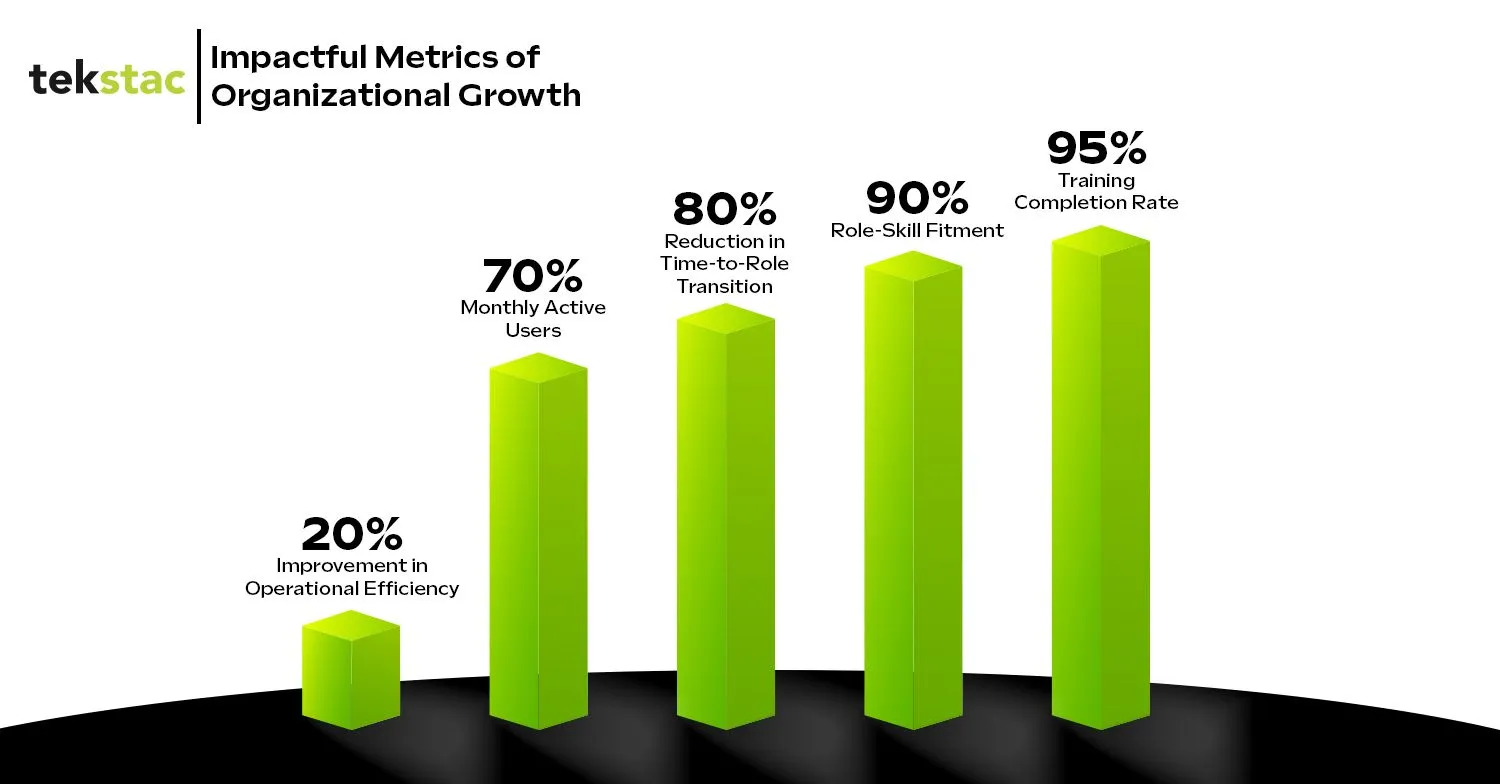
Results That Redefined Workforce Growth
Tekstac’s AI-driven workforce growth framework delivered measurable impact, enabling scalable reskilling, faster talent mobility, and sustainable productivity gains across 300,000+ employees. By leveraging robust reporting mechanisms, personalized learning journeys, and competency assessments, Tekstac empowered employees to transition efficiently into new roles, driving organizational productivity and growth.
Tekstac remains a trusted partner in fostering a future-ready, agile workforce through role-specific skill development.
Ready to accelerate your workforce growth with AI-powered learning analytics?
Book a demo with Tekstac to see how leading enterprises are transforming their workforce with data-driven upskilling.
Talent Mobility Trends in 2025: What Companies Need to Know
What is Talent Mobility?
First, it’s helpful to understand talent mobility. Talent mobility, or internal mobility, refers to the movement of workers across an organization, whether that’s between roles, departments, or locations. Typically, such mobility serves to achieve strategic objectives while also offering growth and development opportunities to employees.
Key Talent Mobility Trends Shaping 2025
There’s plenty for leaders to consider as businesses continue to recover from the pandemic, grapple with the impacts of AI, and navigate a changing workforce with more global and hybrid work than ever—not to mention a need to achieve more with fewer resources. How do you determine where to focus your 2025 strategies? Moreover, how can you ensure you’re able to not only accomplish business goals but also grow employee retention and development?
The answer is a strong talent mobility strategy, and there are several trends to be aware of for 2025.
This next year continues the widespread recovery from the impacts of the COVID-19 pandemic, bringing a renewed focus on workforce strategy and the challenges and benefits of both remote and on-site work. An increasingly global workforce also means more opportunity for employees to change not only their role, but their location.
As AI gains traction, it changes both how companies operate and the work—or upskilling—required of employees. Reliance on AI can save costs and address some talent shortages, but won’t solve all economic challenges faced by companies.
These challenges can all be addressed by a robust talent mobility strategy. Read on to dive into the top six talent mobility trends to watch in 2025.
Top 6 Talent Mobility Trends That Will Define the Future
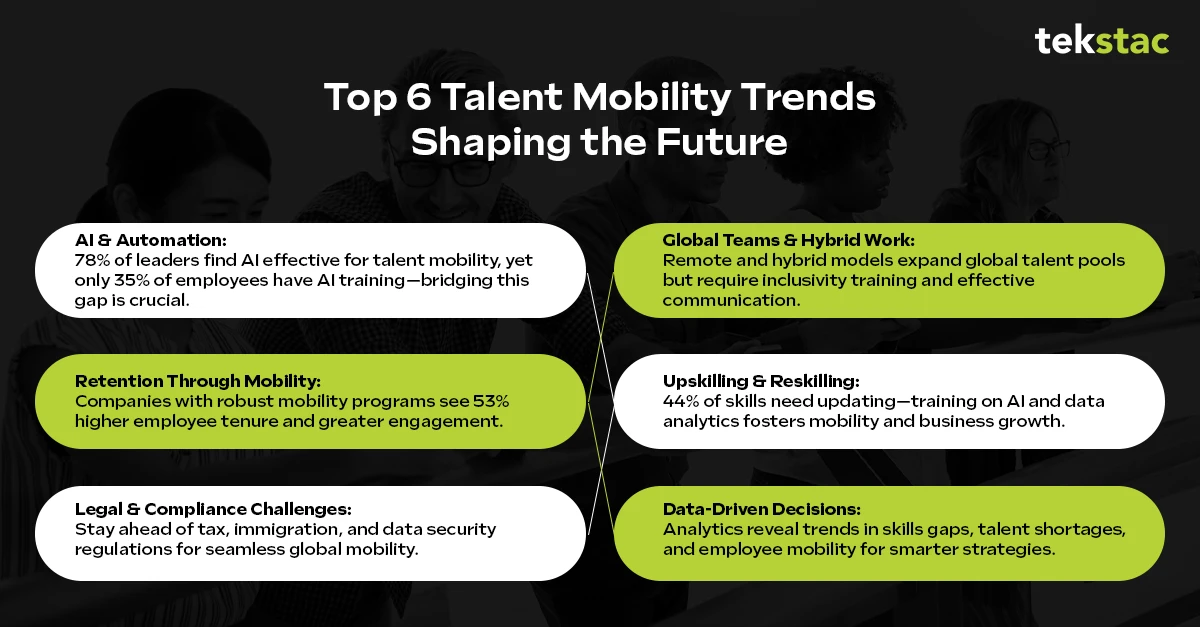
1. AI and Automation
In recent years, AI has shown an ability to match employees with opportunities, with two thirds of leaders making investments in this area and 78% finding AI effective at identifying talent mobility opportunities.
Beyond simply identifying opportunities, the advancement of AI has also opened up new roles for employees who want to grow their AI skills. Although three quarters of companies are adopting AI, just 35% of employees have received AI training. This is a huge opportunity for companies looking to improve mobility.
At the same time, AI can reduce the need for human workers, forcing some employees into mobility they may not have sought on their own. Per the World Economic Forum, future advancements in technology could eliminate 83 million jobs, meaning these workers must pivot into something new.
2. Global Teams and Hybrid Work
When the pandemic thrust employees across the globe into remote work, companies were unprepared for this shift in working styles. Over time, however, many businesses have realized the benefits of a hybrid or remote model.
Not only does global and hybrid expand the talent pool by allowing companies to hire across the world, but building global teams opens up new opportunities to employees who may be interested in relocating.
However, there are challenges to managing global and hybrid organizations, so you must understand how to foster inclusivity and engagement. Train your teams on cultural differences to enable stronger partnership across geographies. Keep time zones in mind when scheduling meetings and deadlines, and focus on transparent communication to keep employees aware of all changes and updates.
3. Talent Mobility as a Retention Strategy
A major benefit of talent mobility is its ability to increase employee retention. For instance, 64% of workers surveyed said that the opportunity to take on international assignments would encourage them to stay in their roles.
But mobility doesn’t have to be cross-continental to be impactful for retention. Companies with plenty of talent mobility options see 53% higher tenures as compared to those without. When employees feel they’re provided with ample opportunities for growth and development, they’re more likely to stay with the organization.
Only a third of organizations have a formal mobility program, but if you’re ready to create a strategy, consider investing in internal job marketplaces (or AI-driven matching), detailed career ladders and pathways, and training opportunities.
4. Upskilling and Reskilling
Nearly two thirds of company leaders report an increasing skills gap among employees, which negatively impacts mobility options. In other words, the ability for employees to move within the company relies upon training and skills development.
And the important skills are evolving—according to the World Economic Forum, an average of 44% of individuals’ skills will need to change, with more priorities placed on skills like AI, data analytics, and other systematic and technological knowledge.
Giving employees a chance to gain new skills will open up mobility opportunities while also meeting key business objectives.
Explore the latest Learning and Development Trends to stay ahead in crafting effective upskilling programs.
Assess the critical skills your teams may be missing, then consider developing internal training opportunities or partnering with skilling platforms or systems. Tekstac, for instance, provides an end-to-end platform to help your team develop and improve their skills.
It will pay off: companies with strong talent mobility programs not only see higher retention, but also 79% more employee promotions to leadership.
5. New Legal and Compliance Challenges
More and more, companies must stay abreast of ongoing changes to global mobility, tax, and immigration regulations. While there are several benefits to global mobility, these employees may trigger tax liabilities or risks companies must be aware of and compliant with.
Additionally, employment law varies across jurisdictions, which requires continued awareness of contract laws, pay and hour requirements, and worker classifications.
Plus, requirements for work visas and permits differ by country, with some countries being easier to move between than others. Staying informed of these details will be critical to a strong mobility strategy.
Finally, you’ll need to understand regional data privacy and security regulations and ensure compliance.
6. Data-Driven Decision Making
Leveraging data analytics to discover market trends, employee needs, mobility patterns, and other information can change the game for your talent mobility strategy.
Rather than relying on anecdotal details, use advanced analytics to see exactly where your teams need to upskill or retrain. At the same time, you can assess past mobility trends, like movement between departments or levels. Combined with employee performance data and business objectives, you can even institute customized mobility options.
Plus, leaders can use data insights to understand trends like talent shortages, skills gap, or global talent maps, which make it easier to decide who to hire and where to hire them.
A robust analytics platform can centralize this data and provide dashboards and visualizations that help you make critical decisions.
What Is the Future of Talent Mobility?
Start the new year off right with a renewed focus on talent mobility. Not only does this improve your employee experience and lead to higher retention, it also gives you a chance to upskill your teams and achieve critical objectives while staying on top of technological advancements.
Be sure to stay informed of changing laws around data privacy, immigration, and employment, and keep an eye on areas your teams could use new skill sets.
For the best shot at growing your teams’ skills and offering increased mobility, you want a platform like Tekstac. With over 500+ learning paths, hands-on practice labs, and comprehensive assessments, you can upskill your team, accelerate talent mobility, and set your employees up for success. See how our platform enhances talent mobility.
Leverage Tekstac’s 360° skilling platform to boost internal mobility, enhance retention, close skill gaps, and cut hiring costs.




